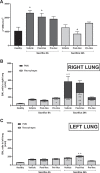Hexarelin modulates lung mechanics, inflammation, and fibrosis in acute lung injury
- PMID: 34871336
- PMCID: PMC8638068
- DOI: 10.33393/dti.2021.2347
Hexarelin modulates lung mechanics, inflammation, and fibrosis in acute lung injury
Abstract
Introduction:: Acute respiratory distress syndrome (ARDS) is an acute form of diffuse lung injury characterized by (i) an intense inflammatory response, (ii) increased pulmonary vascular permeability, and (iii) the loss of respiratory pulmonary tissue. In this article we explore the therapeutic potential of hexarelin, a synthetic hexapeptide growth hormone secretagogue (GHS), in an experimental model of ARDS. Hexarelin has anti-inflammatory properties and demonstrates cardiovascular-protective activities including the inhibition of cardiomyocyte apoptosis and cardiac fibrosis, both of which may involve the angiotensin-converting enzyme (ACE) system.
Methods:: In our experimental model, ARDS was induced by the instillation of 100 mM HCl into the right bronchus; these mice were treated with hexarelin (320 μg/kg, ip) before (Pre) or after (Post) HCl challenge, or with vehicle. Respiratory system compliance, blood gas analysis, and differential cell counts in a selective bronchoalveolar lavage (BAL) were determined 6 or 24 hours after HCl instillation. In an extended study, mice were observed for a subsequent 14 days in order to assess lung fibrosis.
Results:: Hexarelin induced a significant improvement in lung compliance and a reduction of the number of total immune cells in BAL 24 hours after HCl instillation, accompanied with a lower recruitment of neutrophils compared with the vehicle group. At day 14, hexarelin-treated mice presented with less pulmonary collagen deposition compared with vehicle-treated controls.
Conclusions:: Our data suggest that hexarelin can inhibit the early phase of the inflammatory response in a murine model of HCl-induced ARDS, thereby blunting lung remodeling processes and fibrotic development.
Figures




Similar articles
-
Chronic administration of hexarelin attenuates cardiac fibrosis in the spontaneously hypertensive rat.Am J Physiol Heart Circ Physiol. 2012 Sep 15;303(6):H703-11. doi: 10.1152/ajpheart.00257.2011. Epub 2012 Jul 27. Am J Physiol Heart Circ Physiol. 2012. PMID: 22842067
-
One dose of oral hexarelin protects chronic cardiac function after myocardial infarction.Peptides. 2014 Jun;56:156-62. doi: 10.1016/j.peptides.2014.04.004. Epub 2014 Apr 18. Peptides. 2014. PMID: 24747279
-
The Growth Hormone Secretagogue Hexarelin Protects Rat Cardiomyocytes From in vivo Ischemia/Reperfusion Injury Through Interleukin-1 Signaling Pathway.Int Heart J. 2017 Apr 6;58(2):257-263. doi: 10.1536/ihj.16-241. Epub 2017 Mar 17. Int Heart J. 2017. PMID: 28321024
-
Six-week treatment with hexarelin in young dogs: evaluation of the GH responsiveness to acute hexarelin or GHRH administration, and of the orexigenic effect of hexarelin.Eur J Endocrinol. 1999 Sep;141(3):313-20. doi: 10.1530/eje.0.1410313. Eur J Endocrinol. 1999. PMID: 10474131
-
The cardiovascular action of hexarelin.J Geriatr Cardiol. 2014 Sep;11(3):253-8. doi: 10.11909/j.issn.1671-5411.2014.03.007. J Geriatr Cardiol. 2014. PMID: 25278975 Free PMC article. Review.
Cited by
-
Potential Applications for Growth Hormone Secretagogues Treatment of Amyotrophic Lateral Sclerosis.Curr Neuropharmacol. 2023;21(12):2376-2394. doi: 10.2174/1570159X20666220915103613. Curr Neuropharmacol. 2023. PMID: 36111771 Free PMC article.
-
Immunomodulatory activity of β-glucan polysaccharides isolated from different species of mushroom - A potential treatment for inflammatory lung conditions.Sci Total Environ. 2022 Feb 25;809:152177. doi: 10.1016/j.scitotenv.2021.152177. Epub 2021 Dec 4. Sci Total Environ. 2022. PMID: 34875322 Free PMC article.
-
Protective Effects of Hexarelin and JMV2894 in a Human Neuroblastoma Cell Line Expressing the SOD1-G93A Mutated Protein.Int J Mol Sci. 2023 Jan 4;24(2):993. doi: 10.3390/ijms24020993. Int J Mol Sci. 2023. PMID: 36674509 Free PMC article.
-
Treatment with levosimendan in an experimental model of early ventilator-induced diaphragmatic dysfunction.Drug Target Insights. 2023 Apr 13;17:39-44. doi: 10.33393/dti.2023.2574. eCollection 2023 Jan-Dec. Drug Target Insights. 2023. PMID: 37070031 Free PMC article.
-
Growth hormone secretagogues modulate inflammation and fibrosis in mdx mouse model of Duchenne muscular dystrophy.Front Immunol. 2023 Apr 12;14:1119888. doi: 10.3389/fimmu.2023.1119888. eCollection 2023. Front Immunol. 2023. PMID: 37122711 Free PMC article.
References
LinkOut - more resources
Full Text Sources
Miscellaneous

